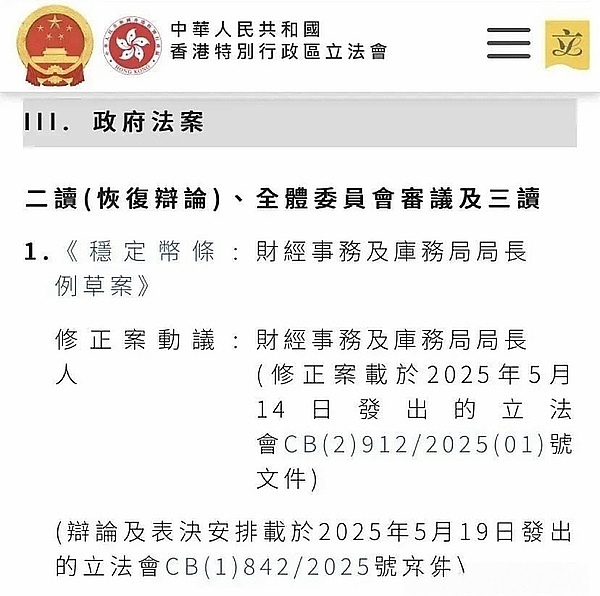The Legislative Council of the Hong Kong Special Administrative Region passed the Stablecoin Bill on May 21, 2025, marking Hong Kong as the world's first jurisdiction to establish a full-chain regulatory system for legal currency stablecoins. This legislative action not only provides a clear legal framework for Hong Kong's virtual asset industry, but also has a far-reaching positive impact on the development of the virtual currency industry in Hong Kong and mainland China by balancing financial innovation and risk prevention and control. Lawyer Liu (web3_lawyer) analyzes the positive significance of the passage of the bill from the two dimensions of Hong Kong and mainland China, combining policy background, industry impact and future trends.

I. Positive impact on Hong Kong's virtual currency industry
(I) Strengthening Hong Kong's position as a global digital asset center
As an international financial center, Hong Kong has continued to make efforts in the field of virtual assets in recent years. The passage of the Stablecoin Bill further consolidates Hong Kong's leading position in the global digital asset market. The bill clarifies the regulatory requirements for stablecoin issuers, including a registered capital threshold of HK$25 million, a 1:1 reserve asset anchored issuance volume, and mandatory protection of unconditional redemption rights. These strict but clear regulatory standards provide a transparent compliance environment for the stablecoin market, which will help attract global investors and companies to choose Hong Kong as the operating center for stablecoin business.
In addition, the Hong Kong Monetary Authority plans to issue regulatory guidelines quickly after the bill is passed and open license applications by the end of 2025. This will attract companies including Standard Chartered Hong Kong and Ansai Group to actively participate and accelerate the development and application of Hong Kong dollar stablecoins. The launch of Hong Kong dollar stablecoins will not only enhance Hong Kong's competitiveness in the field of cross-border payments, but also promote the development of the Web3 ecosystem and inject new vitality into Hong Kong's digital economy. For example, Hong Kong dollar stablecoins can be used for efficient and low-cost cross-border trade settlement, further consolidating Hong Kong's position as an Asian financial hub.
(II) Promoting financial innovation and technological development
The passage of the Stablecoin Bill shows that the Hong Kong government regards stablecoins as an important part of digital financial infrastructure rather than marginal technology. The bill provides a clear compliance path for stablecoin issuers and encourages companies to carry out technological innovation within the regulatory framework. For example, JD.com has entered the stablecoin "sandbox" testing phase in Hong Kong, demonstrating the confidence of enterprises in the Hong Kong market. This "regulatory sandbox" mechanism allows enterprises to test innovative products in a controlled environment, reducing the compliance costs of start-ups while providing space for technology iteration.
As a core component of decentralized finance (DeFi), the legalization of stablecoins will promote the further development of Web3, NFT and Metaverse. The Hong Kong government has begun to lay out virtual asset regulation since 2022, launched public consultation in 2023, and launched a regulatory sandbox in 2024, showing long-term support for the Web3 ecosystem. The passage of the bill will further stimulate the application of blockchain technology in payment, settlement, supply chain finance and other fields, and create a vibrant digital asset ecosystem for Hong Kong.
(III) Enhance market confidence and investor protection
The virtual asset industry is facing a crisis of trust due to past events (such as FTX's thunder). Hong Kong has effectively reduced market risks by establishing a comprehensive stablecoin regulatory system that emphasizes reserve asset management, liquidity and anti-money laundering (AML) requirements. These measures ensure the sustainability of the business model of stablecoin issuers while providing investors with greater security. For example, mandatory 1:1 reserve asset requirements and unconditional redemption rights can effectively prevent the risk of stablecoin decoupling and enhance market trust in stablecoins.
In addition, Hong Kong's regulatory framework seeks a balance between innovation and protection, demonstrating an open and compatible attitude. This balance not only attracts the attention of global crypto companies, but also provides local retail investors with a safer investment channel. For example, ZA Bank has taken the lead in launching virtual asset trading services, supporting Bitcoin and Ethereum transactions, and may further expand to stablecoin transactions in the future. This pioneering demonstration effect will drive more financial institutions to enter the virtual asset market and expand Hong Kong's investor base.
(IV) Promoting cross-border payments and financial connectivity
Stablecoins have the advantages of low cost and high efficiency in cross-border payments. Hong Kong's Stablecoin Act has laid the foundation for the widespread use of Hong Kong dollar stablecoins. The launch of Hong Kong dollar stablecoins will optimize financial connectivity between Hong Kong and other parts of Asia, especially in the "Belt and Road" initiative and the construction of the Guangdong-Hong Kong-Macao Greater Bay Area. For example, Hong Kong dollar stablecoins can be used for cross-border e-commerce, trade settlement and supply chain finance, reducing transaction costs and improving settlement efficiency. This will not only help Hong Kong consolidate its position as a global trade center, but will also provide local companies with more digital financial tools.
II. Positive impact on the virtual currency industry in mainland China
(I) Providing regulatory experience reference for the mainland
Mainland China has a relatively strict regulatory attitude towards virtual currencies, prohibiting cryptocurrency business transactions and ICOs, but is open to blockchain technology. The passage of the Hong Kong Stablecoin Bill provides a regulatory model for the mainland to learn from. Hong Kong's regulatory framework emphasizes the balance between compliance, risk prevention and control, and financial innovation, which is consistent with the mainland's policy goal of promoting the application of blockchain technology in the financial field (such as digital RMB). For example, Hong Kong's "regulatory sandbox" mechanism provides a testing environment for the issuance of stablecoins. This model may inspire the mainland to explore similar pilot mechanisms in specific areas (such as central bank digital currency CBDC or supply chain finance). As a bridge between the mainland and the international market, Hong Kong's successful experience may promote the mainland to gradually relax regulatory restrictions on virtual assets such as stablecoins in the future, especially in the field of stablecoins pegged to the Hong Kong dollar or the RMB. (II) Promoting the internationalization of the RMB Hong Kong's stablecoin bill provides a testing ground for non-US dollar stablecoins (such as stablecoins anchored to the Hong Kong dollar or the RMB). Although Hong Kong's current stablecoin regulation mainly focuses on Hong Kong dollar stablecoins, its open regulatory attitude provides possibilities for the exploration of RMB stablecoins. As an offshore RMB center, Hong Kong has mature financial infrastructure and an international market environment, making it suitable as a test site for RMB stablecoins. If RMB stablecoins are successful in Hong Kong, they will further promote the use of RMB in global payments and settlements, and help the internationalization of RMB.
For example, Hong Kong's stablecoin regulatory framework may provide a compliant channel for mainland enterprises to issue RMB-anchored stablecoins through Hong Kong for cross-border trade and investment. This model can not only enhance the international acceptance of RMB, but also provide mainland enterprises with new financing and payment tools, enhancing their competitiveness in the global market.
(III) Promote the coordinated development of financial technology in the Guangdong-Hong Kong-Macao Greater Bay Area
The Guangdong-Hong Kong-Macao Greater Bay Area is an important region in mainland China to promote the application of financial technology and blockchain technology. Hong Kong's stablecoin bill provides new opportunities for the coordinated development of financial technology in the Greater Bay Area. For example, the Hong Kong dollar stablecoin can complement the digital RMB and jointly serve the cross-border payment, trade financing and supply chain finance needs of the Greater Bay Area. Hong Kong's regulatory experience and mature financial market can provide compliance guidance for companies in the Greater Bay Area and attract more mainland technology companies to enter the international market through Hong Kong.
In addition, virtual asset trading platforms and stablecoin issuers in Hong Kong may cooperate with mainland companies to develop blockchain-based financial products. For example, stablecoins can be used in the Greater Bay Area's supply chain finance platform to solve the problem of financing difficulties for small and medium-sized enterprises. This cross-regional cooperation will promote the integration and development of the Greater Bay Area's financial technology ecosystem.
(IV) Indirectly stimulate the application of blockchain technology in the mainland
Although the mainland is cautious about cryptocurrency transactions, blockchain technology has been widely used in supply chain finance, cross-border payments and digital identity authentication. Hong Kong's stablecoin bill provides a successful case for the commercial application of blockchain technology, which may indirectly stimulate mainland companies to accelerate the research and development and application of blockchain technology under a compliance framework. For example, Hong Kong's stablecoin "sandbox" testing experience can provide technical references for mainland companies and promote the implementation of blockchain in the field of financial technology.

III. Future Trends and Prospects
The passage of the Hong Kong Stablecoin Bill marks a new stage in global stablecoin regulation. In the future, Hong Kong may become a global experimental field for non-US dollar stablecoins, attracting more international companies to enter its market. At the same time, Hong Kong's regulatory model may provide reference for other countries and regions, and promote the coordination and development of global stablecoin regulation.
For mainland China, Hong Kong's successful experience may prompt regulators to gradually relax restrictions on virtual assets in the future, especially in areas related to the internationalization of the RMB. Mainland companies can participate in the global digital asset market through Hong Kong's compliance channels and enhance their international competitiveness. In addition, the financial technology cooperation between Hong Kong and the Mainland will be further deepened under the framework of the Guangdong-Hong Kong-Macao Greater Bay Area, forming a model for regional coordinated development.
IV. Conclusion
The passage of the Hong Kong Stablecoin Bill has a far-reaching positive impact on the virtual currency industry in Hong Kong and Mainland China. For Hong Kong, the bill consolidates its position as a global digital asset center and promotes the development of financial innovation, investor protection and cross-border payments. For Mainland China, Hong Kong's regulatory experience provides a reference for the Mainland, promoting the internationalization of the RMB, the coordinated development of financial technology in the Guangdong-Hong Kong-Macao Greater Bay Area, and indirect stimulation of the application of blockchain technology. In the future, with the maturity of Hong Kong's stablecoin market and its further cooperation with the Mainland, the two sides will occupy a more important position in the global digital financial field and inject new impetus into regional economic development.
 Anais
Anais





